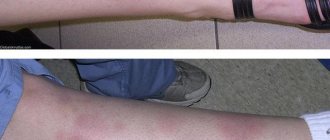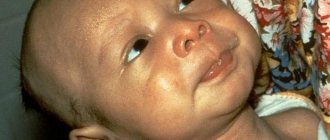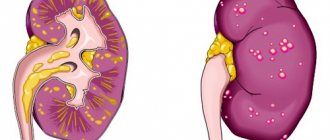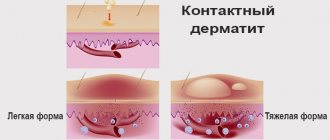A separate niche among psychogenic diseases is occupied by neuroses, also called neurotic disorders. Neurosis – a collective term denoting certain types of neurotic disorders that are reversible and characterized by a persistent, protracted course of the disease.
Neurosis can occur in men and women of different ages, regardless of their social status, level of education, financial security, and marital status. In a special risk group for the development of neurotic disorders are persons who are in the natural biological stages of life - during puberty and in the phase of decline of body functions.
Neurosis is often recorded in children during puberty, when sudden changes in hormonal levels make a teenager especially susceptible to various life events. However, in children, neurosis most often goes away on its own and does not entail the development of dangerous and protracted mental disorders. At the same time, neurosis that arises in adults as they approach old age is fraught with the development of mental disorders and often becomes the cause of diseases of internal organs.
Neurosis implies the manifestation in a patient of a variety of painful phenomena that arose as a result of prolonged exposure to negative stress factors or developed as a result of acute psychological trauma. The leading factor initiating the formation of neurosis is the presence of unresolved internal conflicts in the subject or the external pressure of negative circumstances.
Moreover, the above aspects do not necessarily have to have a high intensity of action: neurosis can be the result of significant mental overstrain or prolonged unrest. Clinical symptoms of certain types of neuroses are numerous and varied, but the dominant positions among the signs of neurotic disorders are the patient’s asthenic status, the presence of obsessive thoughts or irrational fears, or the subject’s demonstration of hysterical reactions.
What can neurosis lead to? Neurosis in the vast majority of cases is the cause of a decrease in a person’s mental activity, a decrease in physical endurance and work productivity, and a deterioration in the quality of work. In addition, the progression of neurosis leads to the fact that a person clearly expresses negative character traits - conflict, irritability, aggressiveness, which ultimately causes limited contacts in society and deterioration of relationships in social groups. If treatment is untimely or incorrectly carried out, neurosis can transform into psychotic-level disorders, which are characterized by a change in the structure of the patient’s personality.
Causes of neuroses
There is a lot of information on how to deal with neurosis, but first of all it is necessary to understand the causes of this disorder. There are two main factors against which the disease develops: psychogenic and intrapersonal. The first category includes situations that provoke psychological trauma. This can be either severe stress (for example, the loss of a loved one), or prolonged nervous tension associated with professional activity or an unfavorable family environment.
Neurosis often arises due to internal contradictions, which generally arise in childhood or adolescence. The root of the problem lies in upbringing errors and psychological trauma, which results in the formation of a vulnerable, indecisive and complex personality.
Treatment
Treatment of neuroses
There are many methods and techniques known about how to treat neurosis if it is characterized by a mental disorder. Let's consider treatment methods through psychotherapy, medication and home treatment.
Treatment of neuroses through psychotherapy involves influencing the patient’s psyche, persuading him, and realizing reality. It is also necessary to identify the root cause of the development of the disease, and if it is embedded in the genes or originates from early childhood, then treatment through psychotherapy alone will be ineffective and will not bring the desired result.
Drug treatment involves taking appropriate medications, the action of which is aimed at restoring processes occurring in the brain. These processes include inhibition and excitation. Bromine is used to stimulate inhibition, and caffeine is responsible for stimulation.
For acute attacks of neurosis, doctors prescribe the following drugs:
- Sibazon;
- Relanium;
- Seduxen;
- Elenium.
The drug Elenium
These drugs are fast-acting and are determined by the effectiveness of the treatment. The principle of the influence of drugs is based on a calming effect on the central nervous system, resulting in a decrease in the symptoms of the disease.
For your information! Do not forget that all medications must be prescribed by a doctor!
There is another common remedy - Amizil. It has a therapeutic effect in neurotic disorders and acts as a corrector of neuroleptic therapy. You should also not forget that all of the medications listed are caused by the presence of side effects, so at the first sign of them you should stop taking them and consult your doctor.
Stages of development of neurosis
In the first stages, neurosis is poorly expressed, which often prevents its timely detection. The initial stage is typical for childhood and is manifested by weak or moderate neurotic reactions to external stimuli. Loud crying, hysteria and whims are typical for many children, so parents rarely pay attention to the first symptoms of the disorder.
At the second stage of the disease, the person becomes increasingly susceptible to stressful situations, and a nervous reaction occurs not only to negative stimuli, but also to joyful events, after which it becomes increasingly difficult for the person to relax and return to a calm state. However, both the first and second forms are easily treatable.
If symptoms are ignored for a long time, the pathology becomes chronic. At this stage, a deep neurosis is formed, during which a radical transformation of the patient’s character and behavior occurs. Advanced forms are difficult to cure completely, and the symptoms of the disease can only be relieved with the help of medications or psychotherapeutic techniques. The danger of a chronic disorder also lies in the fact that the personality forever loses its typical qualities.
Causes of nervous disorders
Neurosis is the result of overstrain of the centers of higher nervous activity, which develops against the background of prolonged irritating effects on them. The disease manifests itself not only in the form of deterioration in psychological health, but also negatively affects the functioning of many internal organs and systems. Most often, disorders of the central nervous system are diagnosed in women who are prone to hysterics and have a hysterical type of character.
The main causes of neuroses:
- increased mental stress, constant stress;
- inability to deal with problems;
- forgetfulness, which became or could cause negative consequences - a forgotten hot iron, water;
- congenital asthenia is a congenital pathology in which a person is not capable of long-term physical and mental work;
- long-term intoxication of the body - neuroses often develop against the background of long-term infectious diseases;
- bad habits.
Important! Mental disorders and somatic necrotic changes are reversible - with timely diagnosis and proper treatment, the disease recedes. But many people are embarrassed to visit a psychiatrist and neurologist, which leads to the development of severe forms of the disease.
Symptoms of neurosis
The disease has many symptoms that can manifest themselves on both a psychological and physiological level. The severity of the disorder depends on many factors, but the main role is played by the lifestyle and individual characteristics of the patient’s nervous system. Due to the fact that women are more emotional, the signs of neurosis are more pronounced in them than in men. However, the general symptoms of neurotic disorder in both sexes are almost the same.
Psychological signs of neurosis
A typical sign of pathology is increased anxiety, which leads to a negative assessment of events and an inadequate perception of reality on the part of the patient. Symptoms of neurosis in women often manifest themselves in the form of constant tearfulness and irritability; men, on the contrary, withdraw more into themselves or begin to relieve stress with the help of alcoholic beverages.
The main psychological manifestations of the disorder:
- emotional instability and sudden mood swings;
- fixation on a negative situation;
- progressive phobias and fears;
- panic attacks;
- guilt and low self-esteem;
- presence of obsessive ideas;
- inexplicable feelings of sadness, loss and longing;
- difficulties in decision making;
- negative thoughts about the future.
Physical signs of neurosis
Advanced forms of pathology are often accompanied by unpleasant physical manifestations. Such symptoms are not the result of individual diseases and are mainly associated with disturbances in the functioning of the autonomic system. Nevertheless, progressive and long-term neurosis can serve as an impetus for disruptions in the functioning of the entire body, which subsequently threatens the emergence of additional health problems. To avoid this, it is necessary to take care of timely treatment of a neurotic disorder at its first manifestations.
Characteristic symptoms of neurosis at the physiological level:
- pain in the chest and heart;
- frequent neurasthenic headaches;
- decreased vision;
- heart rhythm disturbances;
- disturbances in the functioning of the genitourinary system;
- feeling of lack of air when inhaling;
- dermatological problems (the skin is very itchy, various rashes are observed);
- tremor of the limbs;
- increase or decrease in blood pressure;
- excessive sweating;
- dizziness and fainting;
- sleep problems;
- decreased or increased appetite;
- decreased libido (in men - impotence);
- heaviness and pain in the stomach.
Symptoms of the disease
Any symptom of neurosis can act as a manifestation of another disease. In psychological problems, the manifestations directly depend on the stress resistance and sensitivity of the individual. Often, signs of neurosis are attributed to banal fatigue or overexertion. To get rid of the disease, it is necessary to get a general picture of the problem.
Symptoms of neurosis, which appear in most cases, are divided into 2 groups:
- Psychological - a person’s behavior, thinking, and principles change.
- Physiological - a mental illness results in physiological problems (nausea, various pains, etc.).
The severity of symptoms depends on the age of the patient. In children, the disease is more severe than in adults.
General psychological signs
Men and women suffer from the disease. Symptoms that affect psychological health appear first. The most common signs:
- Sudden change of mood.
- Severe self-doubt.
- An overly emotional reaction to any stress, even minor ones.
- Excessive vulnerability.
- Frequent hysterics: a person cannot restrain his emotions, he does not control them and cannot explain them.
- Constant anxiety.
Psychological symptoms of the disease are variable. Decadent moods are replaced by emotional upsurge, and then the person again suffers from depression. Fear and anxiety result in sleep disturbances; the patient becomes lethargic and tired during the day, and cannot sleep at night.
Focusing on one problem is the main symptom that allows you to diagnose the disease. A person cannot stop thinking about what happened, he is concentrated on the event, feeding it with new emotions. Along with focusing on one problem, overall focus decreases.
General physical signs
Over time, physiological symptoms appear. These are obvious manifestations that help in the general diagnosis of the problem. The first to suffer is the cardiovascular system. Due to constant shocks and imaginary problems, tachycardia begins.
Fear affects digestion: the patient either eats a lot or goes hungry. Over time, disturbances in the functioning of the esophagus, i.e., the gastrointestinal tract, appear. Sweating increases, especially during an attack of panic, anger, or when the patient feels intense fear.
Pale skin, dermatitis and allergic reactions are observed. Neck pain appears. Salivation and blood pressure increase, and associated diseases appear. During attacks, the patient experiences dizziness, severe headache, nausea and vomiting.
The body temperature rises - the patient shudders and shakes. Fear causes increased urination and erectile dysfunction. The faster the disease develops, the more serious the physiological manifestations of the disease.
Types of neuroses
There are social, postpartum, motor, school, cardiophobic and informational and other types of neuroses. The most common 5 types of this pathology are:
- Obsessive-compulsive neurosis is a difficult form to treat, based on phobias. The disease affects suspicious, impressionable and insecure people. Chronic obsessive-compulsive neurosis is extremely dangerous because it threatens to transform into more severe mental disorders.
- Neurasthenia (astheno-neurotic syndrome) is a pathology that develops against the background of chronic fatigue. Clinical manifestations: sleep disturbance, headaches, irritability, lethargy, apathy.
- Anxiety disorder - patients with this type of pathology experience constant anxiety and unreasonable fears. Main symptoms: panic attacks, dry mouth, increased heart rate and sweating.
- Hysteria is a type of disorder that women are more susceptible to. Typical manifestations: loud screams, violent sobs, convulsive seizures.
- Hypochondriacal neurosis is characteristic of suspicious people with excessive attention to themselves and their health.
What is neurosis?
Neuroses are functional disorders of higher nervous activity of psychogenic origin. The clinical picture of neuroses is very diverse and may include somatic neurotic disorders, autonomic disorders, various phobias, dysthymia, obsessions, compulsions, and emotional and mental problems. Neuroses belong to a group of diseases that have a protracted course. This disease affects people who are characterized by constant overwork, lack of sleep, anxiety, grief, etc.
People of all ages and social groups are susceptible to neuroses. Similar disorders occur in both children and the elderly. But most often they are observed in people aged 18 to 40 years.
This tendency is associated with the psychological characteristics of the age period when a person enters “adult” life and tries to achieve something in it. Women suffer from psychoneurotic disorders 2 times more often than men. The manifestation of neurosis at a later age is more associated with age-related changes in the body and the gradual weakening of cognitive abilities.
Symptoms such as confusion, hallucinations, and delusions, which are observed in psychosis, are not characteristic of neuroses. Changes in behavior are not typical for neurotic level disorders. Patients are aware of the painful nature of the symptoms that burden them, remain critical of their condition, and strive to get rid of the manifestations of the disease. The course of diseases in this group is favorable. Full recovery is not uncommon for such pathologies, although sometimes treatment can last for many years.
In the modern world, neurosis is a fairly common disorder. In developed countries, 10% to 20% of the population suffers from various forms of neurotic disorders, including children.
In the structure of mental disorders, neuroses account for about 20-25%. Since the symptoms of neurosis are often not only psychological, but also somatic in nature, this issue is relevant both for clinical psychology and neurology, and for a number of other disciplines: cardiology, gastroenterology, pulmonology, pediatrics.
What can neurosis lead to?
Neurosis in the vast majority of cases is the cause of a decrease in a person’s mental activity, a decrease in physical endurance and work productivity, and a deterioration in the quality of work. In addition, the progression of neurosis leads to the fact that a person clearly expresses negative character traits:
- conflict,
- irritability,
- aggressiveness,
- which ultimately causes limited contacts in society and deterioration of relationships in social groups.
If treatment is untimely or incorrectly carried out, neurosis can transform into psychotic-level disorders, which are characterized by a change in the structure of the patient’s personality.
- ICD 10 code: these are codes F40 to F48.
Diagnosis of neuroses
Diagnosis of pathology begins with studying the factors that could lead to its development. First of all, the specialist pays attention to the patient’s heredity, his physical health, as well as the circumstances preceding the appearance of the first symptoms of the disease. A significant role is also given to the dynamics of the manifestations of neurosis: the frequency and strength of symptoms, their dependence on life circumstances and seasonal fluctuations are examined. The diagnosis of neurotic disorder is made only in the following cases:
- in the absence of physical pathologies that could lead to similar symptoms;
- if the disease is long-term and the symptoms are regular;
- if the patient can adequately assess his own reactions;
- if there is no suspicion of more complex types of mental disorders.
Diagnosis of the problem
To get rid of neurosis, a diagnosis is carried out - the patient answers a number of questions and undergoes a routine medical examination. It is necessary to exclude other diseases that could cause a complex psycho-emotional state.
The more the patient tells, the faster the diagnosis will be determined. If neurosis is expressed by physiological symptoms, the severity of such changes and associated health problems are established. It is important to discover the cause of the formation and development of neurosis. Only by eliminating it will a person gain freedom from the disease.
Treatment of neurosis
There are many techniques used to treat the disorder, but there are no general schemes that would help all patients equally effectively. Only a thorough study of the medical history and making a correct diagnosis will allow a specialist to understand whether neurosis can be cured completely and what are the chances that after some time the disease will not manifest itself again.
Methods for treating neurotic disorder:
- Medication. Medicines of chemical and herbal origin are used (tranquilizers, antidepressants, nootropics, anxiolytics, vitamins and minerals, sedatives). The method helps to alleviate physical and psychological symptoms, but medications cannot eliminate the cause of the disease. With the help of pharmaceuticals, neuralgia is treated, which is often a consequence of long-term neurosis.
- Hypnotherapy allows a specialist to study the patient’s subconscious and identify the true cause of the disorder, and then instill in the patient positive attitudes that will contribute to healing.
- Psychotherapy is a technique that helps the patient remember, realize and work through all the factors that led to the development of the disease.
In most cases, an integrated approach gives good results, but the prognosis for a complete or partial cure depends only on how long the disease lasts.
Treatment of the disease
Any mental illness can be healed or its symptoms partially relieved. Treatment of neurosis is a long process that includes various methods, not just psychotherapy. Comprehensive measures to help get rid of the disease:
- Treatment of neurosis with a psychologist - psychotherapy is carried out, which destroys the root cause of the disease.
- Using relaxation techniques (massage, yoga).
- The use of hypnotherapy (works on the same principle as psychotherapy; needed to get out of a serious condition).
- Breathing exercises.
- Autogenic training (psychotherapeutic technique).
- Medicine and other safe means.
- Physical activity, including exercise therapy.
- Pharmacological agents (course of antidepressants, tranquilizers, etc.).
Anyone who has overcome the disease knows that after treatment, the struggle for a normal life is just beginning. Without self-improvement, depression or another symptom will quickly return. The help of a psychotherapist is important for healing. This is a person who will help you understand suppressed fears.
The specialist conducts a deep psychoanalysis and identifies the cause of fear or trauma. Training or exercise therapy will help calm your nerves - physical activity allows you to relieve excess tension. Hypnosis can also help you cope with difficulties.
Automotive training will help cure the disease without antidepressants (a course of drugs prescribed by the attending physician). Getting rid of the problem takes place in a comfortable environment for the patient. Psychotherapy for neuroses and further rehabilitation will allow a person to return to his old life and understand what he really wants.
Psychologist's advice
Treatment of an advanced disease does not happen in one day. The main advice of experienced psychologists is not to rush, because future life depends on the effectiveness of healing. Practical recommendations will help those who are experiencing an exacerbation of the disease.
For treatment you will need to go through several stages:
- The patient admits the problem - this is one of the main stages, according to psychologists.
- The specialist conducts diagnostics and makes a diagnosis.
- The patient receives prescriptions from the doctor, which he must accept without disturbance. Starts to implement them.
- The patient undergoes rehabilitation - recovery. The patient independently performs the practical exercises given by the doctor.
To fight a problem, you need determination and courage. The duration of treatment directly depends on the patient’s desire to overcome the problem, how much time and effort he is willing to invest for his recovery.
Prevention of neuroses
Prevention of neurotic disorders should begin in childhood, since improper upbringing of a child is the main reason for the development of this pathology. Thus, children from an early age should learn to overcome difficulties on their own, have endurance, perseverance and patience.
An atmosphere of excessive permissiveness or, conversely, strictness provokes in the child the development of suspiciousness, uncertainty, anxiety and other initial symptoms of the disease. Therefore, parents should always remember the dangers of neurosis and prevent its initial manifestations.
A favorable environment in the family and team, proper and regular nutrition, proper rest, giving up bad habits, moderate exercise and control of emotions will help to minimize the risk of a severe neurotic disorder. Advanced neurosis can be prevented if you monitor your emotional state, and at the first alarming symptoms, immediately seek help from a specialized specialist.
Stages of the disease
Neuroses are divided into 3 stages, each of which has its own symptoms:
- The initial stage is characterized by increased excitability and irritability;
- Intermediate (hypersthenic) is characterized by increased nerve impulses from the peripheral nervous system;
- The final (hyposthenic) is manifested by decreased mood, drowsiness, lethargy and apathy due to the strong severity of inhibition processes in the nervous system.
If neurosis is not treated, the disease will certainly affect a person’s behavior. The patient begins to understand that not everything is all right with him. Neurotic personality development occurs 6 months to 2 years from the first symptoms of the disease (if it is not treated).
Mandatory ritual - prevention
In addition to potent drugs and medicinal herbs, there are many other methods that can relieve not only muscle tension, but also overcome other barriers caused by neurosis.
Health-improving procedures include breathing exercises, reflexology, physiotherapy (electric sleep, hydrotherapy), and physical exercise. Daily exercises, Nordic walking, running, swimming, skiing.
Exercising in the gym will help normalize the functioning of the heart and endocrine system, improve blood circulation, speed up metabolic processes, strengthen the immune system, and change the emotional background for the better.
Therapeutic baths
Therapeutic and mud baths, wraps, massage will undoubtedly have a positive effect on the nervous system, because the skin, equipped with nerve endings, is the largest organ of the body.
To prepare a healing bath, take a two-liter jar filled with pine needles, hop cones, motherwort herb, calendula flowers, chamomile, and, placing it in an 8-liter bucket, fill it to the top with boiling water, leave for 6-8 hours.
After straining, add to a bath of water whose temperature is 38-40 degrees. Bath time is 15-20 minutes. And so for 8-10 days in a row, preferably before bedtime. As a result of such procedures, anxiety will go away, the feeling of fear will disappear, social life will improve.
If it is not possible to take a bath, a contrast shower can be an alternative. Tested: alternating cold and hot water every 20-30 seconds is an excellent way to cope with an anxiety attack.
Symptoms of neurasthenia
The clinical picture of neurasthenia is characterized by general neurotic disorders, headache and insomnia, as well as various autonomic-visceral symptoms.
The main symptoms and signs of neurasthenia:
- A characteristic feeling is a feeling of pressure on the head, as if the head is being squeezed by a heavy helmet (“neurasthenic helmet”).
- The second complaint of patients with neurasthenia is dizziness, which consists of a feeling of rotation in the head, but is not accompanied by a feeling of rotation of surrounding objects. Most often it occurs during strong excitement, physical exertion, weather changes, etc.
- Symptoms associated with cardiovascular disorders are typical: increased heart rate (tachycardia), palpitations, pressing or stabbing pain in the heart area, arterial hypertension, redness or pallor of the skin. They can appear at the slightest excitement of the patient, even during a lively conversation.
- The most important sign of neurasthenia is decreased performance. Typically, during work, patients quickly develop a feeling of fatigue, weakness, and decreased attention, and therefore productivity decreases.
- Sleep disturbance is one of the main symptoms of neurasthenia: the patient has difficulty falling asleep, often wakes up, and sleep is short. After sleep, the patient does not feel rested and feels exhausted. Increased drowsiness is possible. Due to absent-mindedness and instability of attention, the memorization process becomes difficult, and patients often complain of weakened memory.
- Anxiety, fears - the soul is tormented by various fears, doubts, anxiety at the slightest reason.
- Low self-esteem - a person perceives himself as a loser, a nonentity, a weak personality... He often finds himself with a lot of physical diseases and endlessly undergoes examinations by therapists.
- Impatience - all ability to wait and restrain oneself is lost.
Neurasthenia should be considered as a psychogenic disease, which is characterized by various variations in its course. It can occur in the form of a neurotic reaction and last for several months, or in a protracted form, often lasting for many years.
The duration of the disease in each individual case is determined by the relationship of several factors, such as features of the clinical picture, characteristic personality traits, concomitant physical diseases, features of the pathogenic situation, etc.
Diagnostics
Neurosis (symptoms and treatment in women are interconnected) requires diagnosis. The disease is within the competence of a neurologist, and sometimes the help of a psychiatrist or psychologist is needed. In budgetary organizations, you can contact a local therapist. He will write out a referral to a doctor of the required specialization.
Diagnostic measures include a survey. The doctor needs to know about all the symptoms that bother the woman. Therefore, it is better to indicate all the signs. The color technique is also used to diagnose neurosis. The idea is that a woman is given a palette and asked to choose any color.
There is a high probability of neurosis if the patient draws 1 of the following colors:
- purple (may indicate hysterical neurosis);
- grey;
- black;
- brown;
- red (speaks of hysterical neurosis).
That is, diagnosis of the disease consists of a detailed interview with the woman. The difficulty in determining neurosis is that it is impossible to prescribe laboratory tests that would show the presence of pathology or refute it. Next, the doctor collects anamnesis about concomitant diseases and hereditary factors.
To exclude other pathologies, the following procedures may be prescribed:
- Blood analysis.
- Analysis of urine.
- Ultrasound examination (ultrasound).
- Computer (CT) or magnetic resonance imaging (MRI).
Based on the results of a complete examination, it can be concluded that other pathologies are present. And also determine how well the internal organs work.
Additional treatment information
Neurosis and how to treat the disease are of interest to many who are faced with this problem. If a severe attack occurs, which is accompanied by a breakdown, then first of all the patient is prescribed sedative drugs. These include relaxants and herbal products. After the attack has stopped, individual psychotherapy is prescribed.
What medications can be used must be discussed with your doctor. Additionally, medications for the gastrointestinal tract are often prescribed, as the patient complains of stool disorders, nausea and vomiting. But after high-quality psychotherapy, discomfort and false manifestations quickly disappear without special therapy.
Only a doctor treats neuroses. It is not possible to get rid of the disease using any home remedies. A man's disease is easier to treat than a woman's. Perhaps this is associated with increased hormonal activity of the fairer sex and frequent fluctuations in estrogen and progesterone at different phases of the menstrual cycle.
On the recommendation of the attending physician, neurasthenia can be eliminated using modern methods of integral neuroprogramming, which has found wide application in modern psychotherapeutic practice.
In this case, the illness quickly passes, and the body recovers due to an individual approach to the problem. Bad thoughts are gradually replaced by positive attitudes. First of all, the doctor begins to work with old injuries, identifying what caused damage to the person when he was still a child.
The specialist’s task is to bring the patient’s condition to complete recovery. There are many practices for this. It’s as if the problematic situation is taken out of the depths of the subconscious and worked through. There are ways to destroy a negative image. At the same time, the person’s lost ability to recover from stress returns.
It is recommended to present a negative image on a piece of paper or draw it, then burn it. Again, mentally or realistically. Such pathological conditions related to neuroses are treated depending on the intensity of the manifestation. There are a great variety of techniques available. The doctor will determine which one to use.
How to quickly calm down on your own?
If a woman cannot urgently see a doctor, then she can carry out sedative actions on her own. An optimistic attitude is required to calm down. Calming requires patience, since irritability cannot be overcome in 5 to 10 minutes. Relapses may appear at first.
In order for the body to get used to new conditions, time must pass. The main task of self-calming is a different perception of reality. That is, you need to first assess the situation and then succumb to emotions. Don't forget about activity . With neurosis, a person experiences stress and anxiety. Therefore, a large amount of adrenaline enters the blood.
The body's heart rate increases and the pupils dilate. The hormone acts in the body and the brain sends a signal that you need to run and save yourself. To reduce the effect of adrenaline, it is necessary to expend the energy received. For example, go to the gym, ride a bike. There are many household activities that require energy expenditure - cleaning, gardening.
The famous psychotherapist Vladimir Levi had his own theory about self-soothing during neurosis. To relax faster, you need to tense up a lot. Then spend energy in the gym. You need to force yourself to strain, even if you don’t want to do it. You can scream, jump, but the main thing is to do it with all your might.
After tension, the woman becomes relaxed and her mood improves. The method is not suitable for long-term neuroses. But if the condition appears suddenly, the temper decreases.
If neurosis appears as a result of routine, then some changes need to be made. For example, re-paste the wallpaper, paint the walls a different color. If a woman wants to go to a certain country on vacation, she can take a vacation and go on a trip.
Symptoms of the disease
Currently, there is a classification that identifies certain stages of neurosis. Depending on this, symptoms appear. An experienced neurologist can determine the presence of the disease based on certain signs already at the first consultation.
Symptoms of neuroses may be the following:
- aggressive behavior that manifests itself even under minor stress;
- tendency to fall into despair even over trifles;
- increased tearfulness.
Signs of neurosis are complemented by touchiness, which is not typical in a given situation. A person can become upset even when healthy people do not pay any attention to a minor difficulty. At the same time, such patients tend to exaggerate the problem and invent it.
Symptoms of neurosis in women increase as the menstrual cycle fluctuates. As a rule, closer to menstruation, the signs of the disease become more pronounced. The woman becomes especially vulnerable. Constant anxiety complements symptoms in adults. A person never relaxes, but constantly maintains a tense state. This can also be seen in the muscles. They are often tense and overly mobile. It is quite difficult for sick people to maintain a relaxed state.
How does the disease manifest itself? Often a person becomes fixated on a certain problem. She literally can't get it out of his head. Performance suffers. Neuroses in adults, the symptoms and signs of which often prevent a person from leading a normal lifestyle, worsen social adaptation. The neurologist often notes manifestations of constant fatigue and the inability to concentrate on incoming information. All this is due to a shift in the focus of perception towards the exciting problem. The person seems to notice nothing except the traumatic situation or thought.
If the disease affects children, they become difficult to learn, which reduces their performance compared to their peers. Manifestations also include increased sensitivity to sound and light effects. Patients perceive any rustle with irritation. It is very easy to piss off such a person.
This mental disorder also provokes early awakening. People with this disease have trouble sleeping and have nightmares. The sleep is superficial. Any rustle causes a sharp awakening and increased anxiety.
Causes of the disease
Neurotic disorders have their own causes. The doctor tries to identify them, because only by identifying the provoking factor can one effectively recover. The classification of neuroses identifies separate causes for each type. They are based on a person’s prolonged stay in a stressful situation.
Chronic neurosis, the types of which are also diverse, often occurs in the presence of a traumatic situation for the psyche. This may be a previously unresolved internal conflict that may begin in childhood. The classification of neuroses allows us to distribute the causes depending on the type of manifestations.
The disease can continue for a considerable period. The main thing that distinguishes pathology is a person’s inability to quickly recover from the stress received. That is, some provoking factor operates constantly. It could be:
- long and hard work;
- constant conflicts at home;
- dissatisfaction with oneself.
Some types of neuroses tend to progress. This is an extremely unfavorable factor. Representatives of the stronger sex react sharply to sexual failures and lack of opportunity to express themselves as individuals. The causes of neurosis in men may lie in dissatisfaction with oneself.
Only a neurologist or psychotherapist can make an accurate diagnosis. The causes of neuroses may be the following:
- dead-end and difficult situations from which it is difficult to find the right way out;
- inability to relax and unwind;
- an increased sense of responsibility, which provokes tension;
- overwork;
- difficult emotional situation at home or at work.
Neurosis, the causes of which also lie in the traumas of adolescence and childhood, is sometimes very difficult. A neurologist recognizes the problem immediately by its characteristic symptoms. The cause of the disease is the inability to digest the situation that has arisen. With neurosis, a vicious circle occurs. A person is unable to get out of it. Neurotic disorder intensifies when trying to resist the situation.
What is it and what are the characteristics of this pathological process? The disease develops slowly, stress accumulates gradually. In this case, a provoking factor can be constant employment at work, which requires a lot of effort and dedication. When a person ceases to control the load, the first signs of a neurotic state appear, characterized by increased sensitivity to any stimulus.
Diseases that occur in a severe form and lead to weakening of the body can also provoke pathology. These include HIV, AIDS, oncology and even influenza. In this case, the body begins to suffer not only physically, but also psychologically. It is difficult for such people to recover.
Whatever the type of illness, the reasons always lie in a weak psyche, which is not able to recover quickly, but is prone to self-destruction.
Signs and features of neurosis during menopause
In adult women with menopause, symptoms of neurosis occur at 45-55 years of age. A combination of vegetative-vascular, metabolic-endocrine and neuropsychic changes occurs, the causes of which are a decrease in the hormonal activity of the ovaries and insufficient function of the higher centers of the neuroendocrine system. A woman begins to experience the fear of becoming ugly, old, unnecessary.
Menopausal neurosis refers to the general state of a woman’s psyche
Symptoms of neurosis caused by menopause are similar to those described above and include:
- emotional disturbances (mood swings, emotional instability, irritability, feelings of emptiness and hopelessness, anxiety, difficulty concentrating);
- asthenovegetative (“hot flashes”, asthenia, headache, fainting, discomfort in the chest, fluctuations in blood pressure, appetite, sleep disturbance);
- hypochondriacal (discomfort in the body, itching, fear for health, obsessive search for illness);
- hysterical (lump or spasm in the throat, feeling of body trembling, numbness of the limbs, difficulty swallowing, talking, walking, demonstrative behavior, public sobbing).
Worrying symptoms
Female neurosis is a debilitating, severe mental condition that causes discomfort not only for the patient, but also for those around her. It is characterized by:
- increased irritability;
- bad mood, inability to rejoice;
- sudden mood changes;
- chronic fatigue;
- absent-mindedness, inability to concentrate;
- general severe weakness;
- severe memory impairment;
- inability to carry out daily activities;
- breathing disorders, heart rhythms;
- fainting conditions;
- frequent headaches, heart pain;
- insomnia or drowsiness;
- convulsive symptom.
Causes of anxiety disorder in women
Severe pain is quite rare, but constant, debilitating malaise occurs often. Characteristic phenomena are weakness due to neurosis, inability to engage in physical or intellectual work, loss of interest in life, lack of appetite. Usually there is a whole range of described symptoms, making the daily life of the patient and those around him impossible.
Risk factors
The risk of developing neurosis in women increases in the following cases:
- abuse of bad habits;
- poor nutrition;
- lack of a work-rest schedule (a woman constantly works);
- strong mental stress;
- stress;
- the onset of menopause;
- menopause.
A variety of neuroses
The main subtypes of neuroses traditionally include: obsessive states, hysteria, anxiety disorders (including phobias), neurasthenia.
Obsessive states are characterized by the constant intrusion into the consciousness of unwanted thoughts, ideas, and the performance of periodically repeated ritual actions that temporarily relieve the feeling of anxiety.
A person, for example, periodically washes his hands to prevent infection, or checks that the entrance doors are closed to feel safe. Hysteria manifests itself in the fact that in an instant, without any reason, a person can feel blind or paralyzed, although neither vision nor muscles undergo changes.
Over time, these conditions pass without a trace, but in some stressful situation they are repeated again and again. Hysteria is characterized by a tendency towards drama and theatricality. During seizures, a person may moan or sob loudly, trying in every possible way to be, as they say, the center of attention.
How to get out of a neurotic state on your own
If the disease has been present for a long time and has managed to establish order in the way of life and worldview, then it is almost impossible for a woman to get rid of the symptoms on her own and get out of this state. The help of a specialist is needed, along with which the patient will begin to change her life, starting from the most important and primary problem that gave rise to the neurotic disorder.
Here are some tips that will help eradicate the symptoms of neurosis and help a woman recover from the disease:
- Normalize sleep and wakefulness (sleep at least 8 hours a day, going to bed and waking up without sudden changes in hours).
- Eat balanced, healthy foods without long periods of fasting during the day.
- Do regular exercise that is enjoyable and painless.
- Walk in the fresh air (a walk in the park or on the way to work).
- Include water treatments in your schedule (baths with pine extract or valerian, contrast shower, swimming pool).
- Find time for hobbies, books, favorite movies and music.
- Take herbal sedatives or herbal preparations as a course (if you are not allergic).
- Strengthen family relationships (joint hobbies, sporting events, trips, hikes).
- Establish a regular sex life that brings pleasure to both partners.
- Organize a break from work on weekends and during vacations.
- Apply techniques of muscle relaxation, self-relaxation, autogenic training, meditation, yoga.
- Attend psychological correction and relief groups.
- Love and accept yourself.
Neurosis and psychosis according to Freud
Causes of the disease
Neurosis (symptoms and treatment in women are interrelated) is a condition that appears due to various reasons.
Namely:
- Prolonged experiences or strong mental activity. For example, the disease may appear during a divorce or dismissal from work.
- Inability to solve life's problems. If a woman has an overdue debt, the bank will put psychological pressure on the person. The result is neurosis.
- Loneliness or problems in your personal life. Spending a long time in the company of other people helps fulfill the need for communication. If this is not enough, neurosis appears.
Neurosis is a dangerous pathology. Therefore, having recognized the symptoms, you need to begin treatment.
- High expectations. For example, when a person tries to exceed his capabilities, that is, he “jumps in over his head.” This condition cannot be maintained for a long time. The feeling of an impossible plan can lead to neurosis.
- Self-esteem problems. If a woman has an overestimated or underestimated opinion of herself, then this affects the psyche.
- Forgetfulness, as a result of which an unpleasant situation arose. For example, if an electrical appliance was left on at home, then a fire occurred. Next, the woman will constantly think that she forgot to do something significant.
- Diseases that lead to depletion of the body. This item includes long-term pathologies of an infectious nature - influenza, tuberculosis. The disease also develops due to the abuse of bad habits.
- Diseases of the central nervous system accompanied by an inability to work for long periods of time are congenital asthenia.
- Neurotic disorders that develop for no apparent reason. For example, with a woman’s self-hypnosis.
- Injuries received in childhood. Everything that happens in a child’s life before adolescence is the foundation of personality. If there is an example of a bad lifestyle of parents (use of drugs or alcohol), as well as harsh upbringing (beating, constant raising of the voice), then the likelihood of neurosis increases.
It is generally accepted that the disease is not inherited. But sometimes the condition occurs in relatives.
Neuroses: why they arise and how they manifest themselves
Neuroses are an excellent breeding ground for the occurrence of diseases of internal organs. With a weakened nervous system, the likelihood of intoxication or infection increases.
We recommend reading:
Psychotherapy, tranquilizers and antidepressants in the treatment of neuroses
The pathogenesis of neuroses is explained by the theory of Pavlov, a famous Russian physiologist. His teaching “on higher nervous activity” describes the mechanisms of formation of active foci of excitation in the cerebral cortex and subcortex. According to Pavlov, neurosis is a long-term disorder of nervous activity caused by increased nerve impulses in the cerebral hemispheres. According to the theory of nervous activity, in response to prolonged and constant stimulation of peripheral receptors, persistent foci of excitation are formed in the cerebral cortex.
Methods of treating the disease
Neurosis is treated comprehensively. The disease can be treated only if the main provoking factor is identified. Many people are interested in how long neurosis lasts. Sometimes, pathology can last for decades or more.
In severe forms, treatment of neuroses is carried out in a hospital. In this case, various anti-anxiety medications are used in the form of injections. How to cure neurosis? First of all, you need to contact a specialist who will help diagnose the stage of the pathology. It is important to know which doctor treats neurosis. This problem is dealt with by a psychotherapist and a neurologist.
In most cases, the disease can be successfully treated, of course, provided that the patient himself is aware of the presence of the disease. An unfavorable prognosis for those who treat the pathology at home.
The number of psychotherapy sessions is prescribed by the doctor, and also determines how long this stage is treated and how long you need to visit the hospital. Anti-anxiety medications help restore normal psychological balance. The man relaxes. Is it possible to cure neurosis forever with just pills? The answer is clear: of course not. Drugs only help to bring a person out of a critical situation for him.
Treat psychoneurosis with enough time. It is impossible to solve an old problem in 40 minutes of consultation. First, the doctor determines the stage of the disease and the severity of the symptoms. Then he begins to ask leading questions.
Neurosis is curable, but there is no point in relying on a single visit to the doctor. Psychotherapy involves a large number of sessions. But first of all, the patient must understand the delusion of his thoughts, see their exaggeration.
Prognosis and complications
If treatment is timely, the prognosis for neurosis is favorable. The woman manages to fully recover, prevent recurrence of the disease, and improve her quality of life. If neurosis persists for a long time, serious pathologies form. As a result, therapy will take longer.
The following conditions can be distinguished as complications of neurosis:
- Severe decrease in performance . Due to the fact that a woman cannot concentrate, her thinking deteriorates and her body’s usual work becomes difficult.
- Additional diseases . Due to neurosis, the body cannot adapt to external conditions, and the immune system’s resistance to disease decreases. There is an increased risk of infectious diseases.
- Problems with people around you . When a woman becomes whiny and touchy, it seems to her that she is not understood. These qualities contribute to the emergence of scandals and conflicts.
- Deterioration in quality of life . When a woman has various fears and thoughts, she is forced to avoid the traumatic factor. Because of this, the same actions are performed repeatedly. This is required to understand that the woman did everything right.
A disease called neurosis is a condition in which a woman reacts painfully to what is happening. Symptoms include decreased performance and irritability. Treatment involves the use of medications and folk remedies.
It is also recommended to visit a specialist for psychological therapy. If the disease has just begun, the prognosis for recovery is favorable. But in the case of a long course, therapy will take a long time. Therefore, the most important thing is to visit a doctor at the first suspicion of a disease.
Article design: Oleg Lozinsky
Forecast
The prognosis depends on the form of the disease, the stage of its development and the duration of the course. It is usually favorable. Not the least role is given to the timeliness and competence of medical care. The prolonged presence of neurosis and lack of treatment lead to irreparable personality changes, as well as the risk of suicide attempts.
How long does it take to treat neurosis?
This depends on many factors - the duration of the disease, its causes, the doctor’s experience, and even the desire of the patient himself to be cured. Therefore, each situation is very individual, and it is impossible to answer this question unequivocally. The only thing that can be said for sure is that psychotherapy for these disorders lasts at least a year and should be regular. But the doctor chooses the medication regimen for each patient, and some may need 1 month of taking pills, while others may need several years.
How to distinguish neurosis from VSD?
Vegetovascular dystonia (VSD) and neurosis are interrelated concepts. VSD is a complex of symptoms of different localization that occur when there is a malfunction in the autonomic nervous system. And neurosis is a disorder of the central nervous system caused by the psyche (stress, depression, etc.). Since the nervous system is connected, disturbances in one department provoke malfunctions in the other.
Therefore, VSD and neurosis often imply each other. The symptoms of the conditions are similar. A distinctive feature of VSD is dystonia (spasm) of cerebral vessels.
It is difficult to distinguish between neurosis and VSD. If both conditions are present in a woman’s body, then the disorders affect not only the nervous system, but also other organs.
Signs of neurosis in women and men
In women, neurosis has certain characteristics. Most often, in representatives of the weaker half of humanity, the disease develops according to the asthenic type. The woman becomes irritable, her mental and physical performance deteriorates, and problems appear in the sexual sphere.
Neurosis during pregnancy
In pregnant women, the symptoms of a neurotic state have their own characteristics. For example, in such women:
- the emotional background is very low, and the general depression is too high. Consistently bad prevails
- mood and dark thoughts, apathy and severe irritability;
- specific phobias develop: a woman is afraid that a miscarriage will occur or a child will be born with illnesses; it may seem to her that her husband is no longer attracted to her;
- various psychogenic manifestations: severe dizziness, arrhythmia, sweating, etc.
Treatment of neurosis during pregnancy does not involve taking any psychotropic drugs. You just need to change your lifestyle and use psychotherapeutic techniques.
But sometimes psychotherapy does not bring the desired result. In this case, treatment with folk remedies and taking herbal-based sedatives can be effective.
Neuroses in men
Men are diagnosed with the following types of neuroses:
- Depressive neurosis. It is this type of disorder that occurs in men more often than others. The disease can be triggered by various external problems, for example, the inability to realize oneself in the professional sphere, the inability to adapt to changes occurring in life.
- Neurasthenia in men. The disease manifests itself due to emotional stress, or against the background of physical fatigue. Mostly workaholics suffer from male neurasthenia.
Women and men can develop climacteric neurosis, which begins in the age period from 45 to 55 years. Its symptoms: increased irritability, lack of emotional stability, worsening sleep, disruption of internal organs, and lack of stamina.
Psychological work on yourself
Treatment of neuroses in some cases does not require medical intervention. When the first symptoms of abnormalities in the functioning of the nervous system are detected (excessive nervousness, sleep disturbances, increased emotionality, irritability, biased mood swings), a person should resort to psychological work with himself.
A non-drug method of treating neuroses at home involves following recommendations such as:
- Take proper time to rest. Doctors recommend going to bed no later than 10 pm, and this should be done in a well-ventilated, cool room.
- Periodically take medicinal baths with herbs or aromatic oils. This will help a person restore not only psychological resources, but also physical ones.
- Find a hobby and devote time to it, immersing yourself in your favorite activity as much as possible. When doing something pleasant for oneself, the patient needs to try not to think about extraneous things, completely focusing the flow of his thoughts on the current pleasure.
- Talk through the moments that provoke the onset of neurosis at least 1-2 times a day. Scientists have proven that by verbally experiencing negative emotions and memories several times, it is easier for a person to come to terms with what happened and stabilize his mental state.











